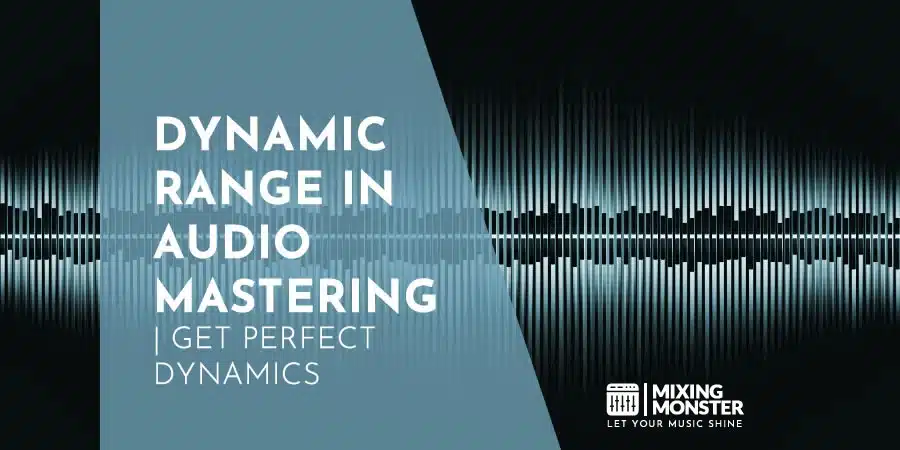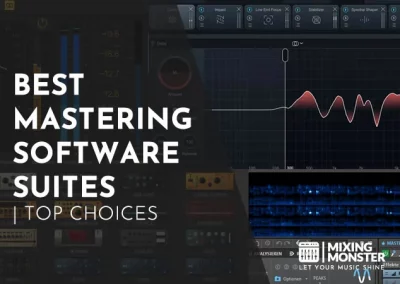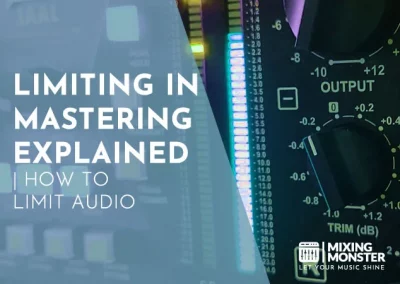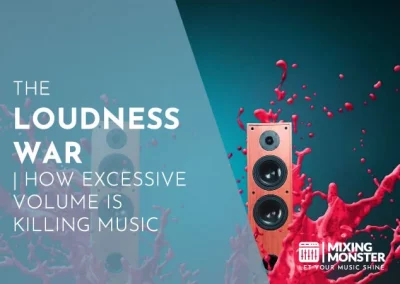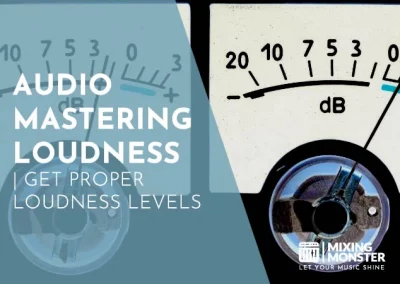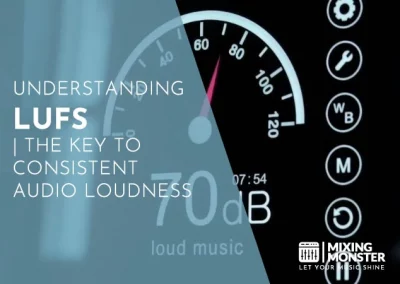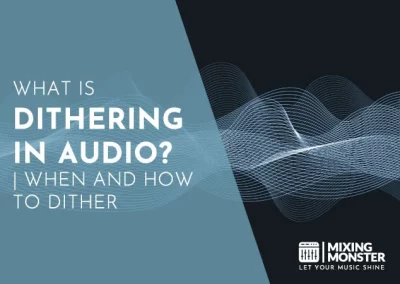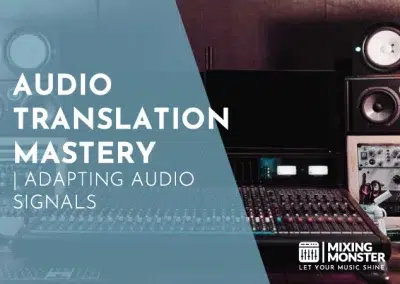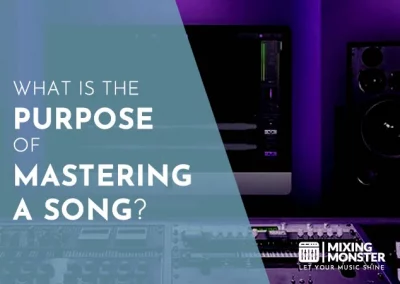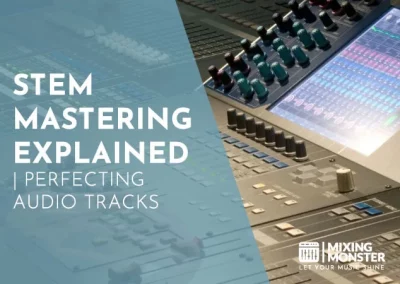Home > Blog > Mastering > Mastering Insights
Dynamic range in audio mastering is a critical factor in audio processing, as it determines the clarity, punch, and emotional impact of a piece of audio. By carefully controlling the dynamic range, a mastering engineer can create an audio mix that is engaging and dynamic, while still maintaining the intended emotional content of the music.
Dynamic range in audio mastering refers to the difference between the loudest and softest sounds in a recorded or mixed piece of audio. It is a measure of the amplitude range of an audio signal and is usually expressed in decibels (dB). Dynamic range is an important aspect of audio mastering as it influences the overall sound quality and listening experience of the audio.
There are several important key aspects to consider, when discussing the topic of dynamic range in audio (mastering). There is a “loudness war” out there: make sure to fight the good fight!
Table Of Contents
1. What Is Dynamic Range In Audio?
2. Key Aspects Of Dynamic Range In Audio Mastering
3. What Is A Good Dynamic Range In Audio Mastering?
4. How To Control Dynamic Range In Audio Mastering
5. How To Meter Dynamic Range In Audio Mastering
6. Dynamic Range In Different Music Genres
7. Get Perfect Dynamic Range In Your Mastering Sessions

1. What Is Dynamic Range In Audio?
In general, dynamic range in audio processing refers to the difference between the loudest and softest sounds that a piece of audio equipment or software can reproduce.
It measures the amplitude range of an audio signal and is usually expressed in decibels (dB). The dynamic range of an audio system has a significant impact on the overall sound quality and listening experience of the audio.
Dynamic range plays a crucial role in audio processing because it influences the clarity, punch, and emotional impact of the audio. A wide dynamic range allows for more nuance and detail in the audio, while a limited dynamic range can lead to a flat, lifeless sound.
For example, a system with a high dynamic range can accurately reproduce a wide range of sounds, from quiet whispers to powerful explosions, while a system with a low dynamic range may struggle to accurately reproduce quiet or soft sounds, or may introduce unwanted distortion at higher volumes.
The dynamic range of an audio system is influenced by several factors, including the quality of the components, the design of the system, and the processing algorithms used to amplify and shape the audio signal.
When evaluating audio systems, it is important to consider the dynamic range of the system, as it can greatly impact the overall sound quality and listening experience. In general, audio systems with a high dynamic range are considered to be of higher quality, as they allow for a more nuanced and detailed sound.
However, the dynamic range required for different applications can vary. In some cases, a limited dynamic range may be acceptable or even desirable, for example, in situations where a powerful, driving sound is desired, such as in live rock concerts or dance clubs.
By understanding and carefully controlling the dynamic range, audio engineers and producers can create audio that is engaging, dynamic, and in the end well produced and processed art.
2. Key Aspects Of Dynamic Range In Audio Mastering
In audio mastering, the dynamic range of a recording is carefully controlled to ensure that the audio remains clean and free of unwanted distortion, while still maintaining the intended emotional content of the music.
When discussing the topic of dynamic range in audio mastering, several key aspects are important to consider:
Key Aspects Of Dynamic Range In Audio Mastering:
- Loudness:
The perceived loudness of a recording is a crucial aspect of dynamic range, as it affects how the music is perceived by the listener. A mastering engineer must balance the loudness of a recording with its dynamic range to create an engaging and dynamic listening experience. - Headroom:
Headroom refers to the amount of space between the peak levels of a recording and the point at which distortion or clipping occurs. Maintaining adequate headroom is important in audio mastering to ensure that the audio remains clean and free of unwanted distortion. - Compression:
Compression is a common tool in audio mastering used to control the dynamic range of a recording. The right amount of compression can enhance the overall sound, but too much compression can lead to a loss of dynamic range and a flat, lifeless sound. - Equalization:
Equalization, or EQ, is a less important aspect in audio mastering regarding dynamic range. However, by adjusting the frequency balance of certain elements in the stereo field, the perceived loudness and dynamics of a musical element can be altered as well. - Limiting:
Limiting is a type of dynamic processing that is used to prevent audio levels from exceeding a set threshold. This helps to prevent clipping and ensures that the audio remains within the desired dynamic range. - Stereo Image:
The stereo image of a recording is the way in which the sounds are perceived in the stereo field. A mastering engineer must consider the stereo image and its impact on the dynamic range to ensure that the audio is balanced.
It is one of the most important tasks of a mastering engineer to ensure that the dynamics of a mix are controlled, yet preserved and sometimes meticulously enhanced in order to create the best possible listening experience.

3. What Is A Good Dynamic Range In Audio Mastering?
There is no one answer to what constitutes a good or common dynamic range when mastering a song, as it can vary greatly depending on the genre, style, and artistic intent of the music.
The dynamic range of recorded music has been decreasing in recent years due to the widespread use of loudness normalization algorithms and the perceived loudness war.
Some genres, such as classical, jazz, and acoustic music, typically have a wider dynamic range, allowing for more expressive and nuanced playing, while other genres, such as pop, hip-hop, and electronic dance music, often have a more limited dynamic range, with a focus on a consistent and energetic overall volume level.
We will discuss the influence a genre has on dynamic range in section 6.
In general, a dynamic range of around 10-12 dB is considered to be a good starting point for most popular music, while dynamic ranges of 6-9 dB are not uncommon for contemporary dance and electronic music. Here are some rough guidelines for dynamic range in dB values in some common music genres:
Dynamic Range Values In Different Music Genres:
| Classical: | 20-30 dB |
| Jazz: | 12-20 dB |
| Blues: | 10-15 dB |
| Rock: | 10-15 dB |
| Pop: | 6-12 dB |
| Electronic Dance Music (EDM): | 6-9 dB |
| Hip-Hop: | 6-9 dB |
However, it is important to note that these are rough guidelines, and the optimal dynamic range for a given song will depend on a variety of factors, including the musical genre, the production style, and the desired listening experience.
Ultimately, the goal of the mastering process is to create a cohesive, polished, and dynamic audio experience that accurately represents the intended sound of the song.
Whether that requires a wide or limited dynamic range will depend on the specific needs of each song, the whole album composition and the artistic vision of the artist and producer.

4. How To Control Dynamic Range In Audio Mastering
Audio mastering engineers have several tools and techniques at their disposal to process the dynamic range of a song:
How To Control Dynamic Range In Audio Mastering:
- Compression:
Compression is the most common tool used by mastering engineers to control dynamic range. Compression reduces the level of the loudest parts of a song, while boosting the level of the quietest parts, to create a more consistent overall volume level. The engineer sets the threshold and ratio parameters to determine how much compression to apply, and adjusts the attack and release times to fine-tune the effect. - Limiting:
Limiting is a more aggressive form of compression that sets a hard ceiling on the maximum volume level of the song. Limiting is often used in mastering to prevent digital clipping and ensure a consistent maximum volume level. It often defines the “peak” of the dynamic range. - Stereo Imaging:
Stereo imaging techniques allow the mastering engineer to adjust the stereo field and enhance the perceived width, depth, and placement of sounds within the mix. These adjusments can have an impact on the dynamic range in terms of perception of louder or quieter parts inside a given dynamic range. - Volume Automation:
Automating the volume of a song in mastering can help to underline the overall characteristic of a song. It can also be a measure to control and balance louder or quieter parts and thus have an impact on the dynamic range of the song.
These are just a few of the tools and techniques that a mastering engineer can use to process the dynamic range of a song. The goal of the mastering process in terms of dynamic range is to create a cohesive, yet dynamic audio experience that accurately represents the intended sound of the song.

5. How To Meter Dynamic Range In Audio Mastering
A mastering engineer can meter the dynamic range of a song using a variety of tools:
Tools To Meter Dynamic Range:
- Dynamic Range Meter (DRM):
A DRM is a specialized software tool designed to measure the dynamic range of audio recordings. A DRM calculates the difference between the loudest and quietest parts of a song and displays the result in dB. Some popular DRM software tools include True Peak and ISOWave, among others. - Loudness Meters:
Loudness meters are commonly used in audio mastering to measure the perceived loudness of a song, taking into account the way human hearing works. This is important because our perception of loudness is not the same as the actual sound pressure level, and a song that sounds loud to us may not actually have a high sound pressure level.
Some popular loudness meters include the ITU-R BS.1770 loudness meter, the EBU R128 loudness meter, and the ATSC A/85 loudness meter, among others. - Spectrum Analyzer:
A spectrum analyzer is a tool that displays the frequency spectrum of an audio signal, allowing the mastering engineer to see how the different frequency ranges are balanced within the dynamic range. This can be useful for identifying tonal imbalances, correcting EQ issues, and ensuring that the audio has a cohesive and balanced sound.
In terms of workflow, a good approach for mastering engineers when metering dynamic range might include the following steps:
How To Meter Dynamic Range In Audio Mastering:
- Calibrate The Monitoring System:
Before beginning the mastering process, it is important to ensure that the monitoring system is calibrated and that the levels are set correctly. This will help ensure that the mastering engineer has an accurate reference for the sound of the audio. - Load The Song Into A DRM Or Loudness Meter:
Once the monitoring system is calibrated, the mastering engineer can load the song into the DRM or loudness meter and begin the metering process. - Measure The Dynamic Range Or Perceived Loudness:
The DRM or loudness meter will display the dynamic range or perceived loudness of the audio in real-time. The mastering engineer can use this information to make informed decisions about how to adjust the dynamic range of the audio, either by using compression, limiting, or other dynamic range processing tools. - Use A Spectrum Analyzer:
The mastering engineer can then use a spectrum analyzer to view the frequency spectrum of the audio and make informed decisions about how to balance the different frequency ranges. - Keep Measuring The Dynamic Range:
The mastering engineer can repeat the process of measuring the dynamic range and adjusting the audio as needed until the desired result is achieved at any given point in time. It is especially useful after applying limiting or compression to the song.
This is just one possible workflow for metering dynamic range in audio mastering, and the specific approach used by a mastering engineer will depend on their individual preferences and the specific needs of each song.
The goal of the metering process is to ensure that the audio has a cohesive, balanced, and dynamic sound while meeting modern loudness standards.
6. Dynamic Range In Different Music Genres
As already discussed in section 3, the genre of music can greatly impact the dynamic range of a song. Different music genres often have distinct characteristics and conventions when it comes to dynamic range, as a result of the musical intention, the cultural influences, and technological developments.
Here are some examples of how different genres of music can impact the dynamic range of songs:
Dynamic Range In Different Music Genres:
- Classical Music:
Classical music often has a wide dynamic range, with quiet passages and soft instrumentation contrasted by sudden outbursts of sound from the full orchestra. This dynamic range creates a sense of contrast and adds emotional impact to the music. - Rock Music:
Rock music often has a more limited dynamic range, with a focus on loud, driving rhythms, compressed high-gain guitars and powerful vocals. This limited dynamic range creates a sense of intensity and energy, but can sometimes lead to a lack of nuance and detail in the audio. - Jazz Music:
Jazz music often has a medium dynamic range, with a focus on subtlety and nuance in the instrumentation and vocals. This dynamic range allows for a rich, detailed sound, while still maintaining a sense of energy and excitement. - Film Scores:
Film scores often have a wide dynamic range, with quiet, suspenseful moments contrasted by powerful, epic orchestral pieces. This dynamic range creates a sense of atmosphere and enhances the emotional impact of the film. - Pop Music:
Pop music often has a limited dynamic range, with a focus on a bright, punchy sound that cuts through the mix. This limited dynamic range creates a sense of energy and excitement, but can sometimes lead to a loss of nuance and detail in the audio as well.
Ultimately, the dynamic range of a song is influenced by a combination of factors and individual creative choices made by the artist, producer, and audio engineer.

7. Get Perfect Dynamic Range In Your Mastering Sessions
Achieving the “perfect” dynamic range in audio mastering is a subjective process that depends on the desired sound of the song and the intended listening experience.
The ideal dynamic range will vary depending on the genre of music, the individual song, and the artistic intent of the musician and producer.
Understanding the typical dynamic range for the genre of music you are mastering can help guide your decisions about how much dynamic range to preserve or reduce in the audio.
Using dynamic range meters, loudness meters, and spectrum analyzers can help you make informed decisions about the dynamic range of your audio.
Try different processing techniques, such as compression, limiting, or volume automation, to adjust the dynamic range of the audio. Listen to the audio carefully and make informed decisions about how to balance the loudness and quietness of the audio.
Listen to songs in a similar genre to the one you are mastering, and use them as a reference point for the desired dynamic range.
Ultimately, the best way to achieve the desired dynamic range in your audio is to trust your ears and make informed decisions based on what you hear. This requires trained hearing and musical experience, but can be done.
Preserving dynamics while producing an engaging and loud song is often a trade-off. Don’t be afraid to produce a more “quiet” tune which has very tasteful dynamics and nuances instead of “cranking” its loudness and destroying the initial musical intention.


